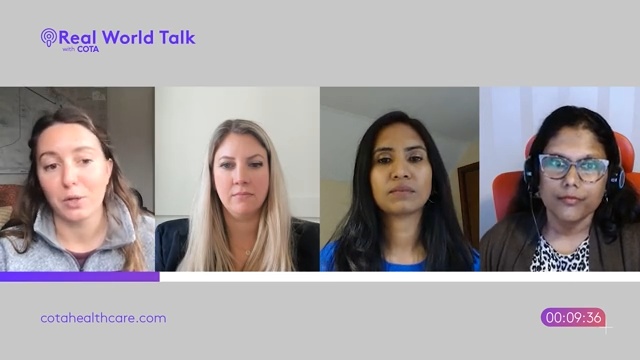Learning How Combining RCTs and RWD Helps With Patient Outcomes Featuring Seshamalini Srinivasan, Laura Fernandes, and Karla Feghali
Subscribe on your favorite platform:
Summary
Real world data (RWD) is data that’s collected outside of clinical trials, whereas randomized controlled trials (RCTs) are conducted to measure the effectiveness of a specific medication or treatment. But how can these two work together to improve patient outcomes?
In this episode of the Real World Talk podcast, our host Mandy Kelly welcomes Seshamalini Srinivasan, Laura Fernandes, and Karla Feghali to talk about the importance of combining RWD and RCTs to bring life-saving treatments to patients faster.
Highlights
- [01:00] Introduction — Our host Mandy Kelly welcomes Seshamalini Srinivasan, Laura Fernandes, and Karla Feghali. Seshamalini specializes in the data and analytics space, and Karla is a senior manager at ConvergeHEALTH by Deloitte Practice. Laura is a senior statistical director at COTA.
- [03:40] How to leverage massive amounts of real-world data to benefit the patient? — Real-world data gives you a different perspective. Karla explains, “When you actually have that patient in the room, and you’re collecting that information, you’re getting point-in-time data. But combining that data with real-world data gives you a holistic picture of that actual patient and helps you understand other factors that could potentially be influencing the outcome of that patient’s health and how they’re going to perform in that overall trial. Combining that with real-world data gives you that 360° view and gives you that different perspective.”
- [05:43] Comparing RCTs and RWD — Seshamalini Srinivasan explains the difference between randomized control trials and real-world data. As opposed to RCT, RWD is answering a different question.
- [10:06] Real-world data will fill in the gaps of information — Laura says, “There’s been an effort to expand how clinical trials are conducted, and that is where I feel real-world data will definitely come into this picture to fill in our gaps of collected information and understanding how the drug actually works.”
- [12:35] The cost of clinical trials — The cost of clinical trials is another concern in the healthcare industry.
- [15:47] A lot of time goes into operationalizing clinical trials — According to Seshamalini, half the time is spent on recruiting and retaining patients. She says, “That’s our guiding principle as well within ConvergeHEALTH Minor. Can you bring all of this data together so researchers can analyze it and look at it on the same ground because that can help you pull insights across these data sets?”
- [17:33] There’s an excellent use of real-world data — Laura talks about the top use cases of RWD within the regulatory setting.
- [20:03] The challenges of RCT data and RWD — According to Seshamalini, there are a lot of challenges with collecting RWD. She says, “It is very challenging because, think about it, the purpose and the intent with which it was collected. Right there, it’s a completely different purpose. RCT is in a very tight, controlled environment. There’s RWD; you’re passively collecting it. You don’t have control over the source. You know how it gets transformed. So there are a lot of things going on there, all of which will result in this thing called bias.”
- [26:19] RWD trends — Karla talks about the RWD trends we see within the regulatory industry.
- [24:11] Improving trial efficiency through Master Protocol — We often forget about patients’ resources when we’re recruiting them for clinical trials. According to Karla, the concept of Master Protocol might help improve trial efficiency.
Key Points
- Real-world data can give you a unique perspective on the patient. When you combine clinical trial data with real-world data, you get a better view of the patient’s case. Karla says, “Combining that with real-world data like I said, gives you that 360° view and gives you that different perspective because in the room, you’re discussing with this patient who’s in a trial, and they’re giving you maybe 50% of the story. But did they not sleep well the night before? Did they exercise? Are they eating poorly in some cases? And taking some of that patient-reported outcome data in combination with some of their historical data and how they’ve been seen in the past with the medical professionals — you can just combine that and utilize that much more effectively.”
- Real-world data is here to stay. We have so much more data than we’ve ever had before. According to Laura, real-world data is the future. She says, “I think, on the real world data, there’s a huge spotlight now, and the pandemic also made us realize that it is also difficult to collect information in this controlled fashion, and so, we are thinking of other ways to expand how clinical trials are conducted. Decentralized clinical trials is another thing that’s coming up now — how to go to where the patient is instead of asking the patient to come to these clinical trial centers.”
- How to tackle the biases of clinical trials? There are many challenges of RWD. Laura says, “Earlier, I mentioned that clinical trials also have certain biases, and we take care of those biases in a clinical trial by having different safeguard measures in place. So we need to have similar safeguards in place for using real-world data. There’s no free lunch in some sense. So, even in the case of real-world data, what are the kinds of measures we need to put in place, how to avoid selection bias, how to avoid temporal bias, how to take care of this whole missing bias — this bias that might creep in if you do not have complete data. So, those are the kinds of things that are going to be forthcoming; I think we are expecting two different guidances from the FDA, and how to handle those biases is going to be expanded upon in those guidance documents.”
